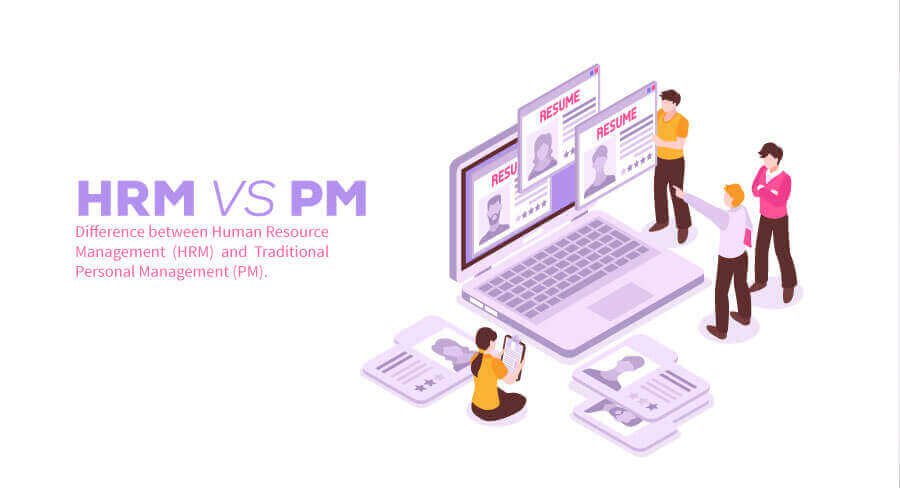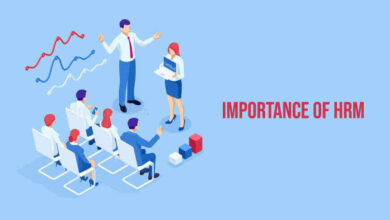Difference between Human Resource Management and Personal Management
Some important concerns include meeting people’s needs and creating effective ways to hire, develop, evaluate, and reward them. There is a difference between human resource management and personnel management or HRM vs PM. Traditional personnel management tends to be parochial, striving to attend to line managers, whereas HRM is integrated into the role of line managers, with a strong proactive stance and bias towards business. PM has a history of placing emplacing emphasis on bureaucratic control often in a reactive sense, i.e., control of manpower and personnel systems. PM has been characterized as a highly segmented system by others.
Some personnel managers will no doubt see the growing influence of personnel systems. Beer (1997) identified major obstacles in transforming the traditional administrative personnel function and moving problems in the transformation of HR professionals who do not possess the requisite analytical and interpersonal skills.
What is Human Resource Management (HRM)?
Human Resource Management (HRM) is the process of managing and directing people for a variety of purposes, such as to achieve organizational goals, to produce a desired product or service, or to create a workplace that promotes employee health and well-being. It involves coordinating various elements of the human resources function within an organization such as recruitment, selection, and training; performance appraisal; compensation; benefits administration; employment law compliance; employee relations; labor relations – including labor market intelligence – and legislative compliance.
In this context, human resource management also refers to an organization’s human resource activities rather than its employees’ human resources.

What is Traditional Personnel Management?
Traditional personnel management is a system of human resource management that involves the use of supervisors, managers, and employees. It relies on a hierarchy in which employees are assigned to positions based on their skills and knowledge. The traditional personnel management model is typically used for large organizations with more than 1,000 employees.
Traditional personnel management can be broken down into two parts: employee recruitment and selection; and the deployment of employees within the organization. Recruitment refers to identifying the right candidates who possess the necessary skills and experience required to perform their jobs effectively. Selection refers to ensuring that these candidates meet all requirements before hiring them. The deployment phase involves assigning these individuals to specific departments or job roles within an organization.
Difference between Human Resource Management and Personal Management
Strategic concerns and how human resource contributes to the attainment of business goals are given more attention in HRM. HRM emphasizes the value of adaptability, quick thinking, and flexibility. PM can be described as a series of activities related to several of an employee’s relationships with the organization. The difference between traditional personnel management and human resource management are given below:
| Dimensions | PM | HRM |
|---|---|---|
| Definition | PM is the process of hiring and developing employees so that they become more valuable to the organization. | HRM is the process of hiring, developing, and maintaining effective workforces in an organization. |
| Key Concern | Labors | All employees |
| Planning and Strategy Formulation | PM is involved in operational planning only. | Participates in establishing the strategic plan’s overall organizational structure and coordinating human resource operations with it. |
| Authority | Medium status and authority | High status and authority for the top personnel officer |
| Scope | PM is concerned primarily with hourly, operational a clerical employees. | HRM is concerned with all managers and employees. |
| Decision Making | Makes operational decisions only | HRM is involved in making strategic decisions. |
| Behavior Pattern | Employees’ behavior depends on the organization’s values/mission. | Employees’ behavior depends on organizational norms or customs and practices. |
| Integration | It involves moderate to small integration with other organizational functions. | It is completely interwoven with the marketing, financial, legal, and production aspects of the business. |
| Coordination | Does not coordinate all human resource functions. | Coordinates all human resource activities (e.g. training, recruitment, staffing, equal employment opportunity). |
| Basis of Management Action | Management takes action on the basis of procedures. | Management take actions on the basis of business need. |
| Rules | Importance of devising clear rules | HRM observes the progress of coping with rules. |
| Speed of Decision | Personnel management takes decisions slowly | HRM takes decisions quickly. |
| Respect for Employees | Labor is viewed as a tool that can be replaced and is disposable. | People are viewed as resources to be utilized for an organization, its workers, and society at large. |
| The focus of Attention for Interventions | Personnel Procedures | Wide-ranging cultural, structural, and personnel strategies |
| Shared Interests | Interests of the organization are uppermost. | Mutuality of interests |
Similarities Between Personal Management and HRM
The similarities between personal management and human resource management are many. Both involve the management of individuals and groups, both are concerned with the effective use of resources, both are concerned with performance and productivity, both require a wide range of skills and experience to be effective, and both have some degree of initiative from the employees themselves.
Both personal management and human resource Management also have similarities in that they are both concerned with how people can be managed effectively. This means that they need to be able to manage people within their organization in order to maximize their potential as an individual or groups within the organization. This can mean that managers need ways of motivating employees in order to get them working towards achieving certain goals, or it could mean that managers need to provide training for new hires so that they will be able to perform at their best when they start working for the company.
Another similarity between personal management and human resource management is that both involve managing multiple individuals or groups within an organization. In this way, there are some similarities between both fields; however, it is still important for managers in one field (for example) to understand how things work differently in another field.
Final Decision
The final section of the paper discusses the similarities and differences between human resource management and personal management. The similarities are that they both deal with people in organizations. Both are concerned with the development and effective use of human resources. And both have similar roles and responsibilities.
The difference between human resource management and personal management is discussed above. The first difference is that HRM has a more structured approach to managing employees while personal management focuses more on people’s interests and values. In addition, HRM deals with all aspects of employment-related issues while personal management is focused on just working relationships (i.e., how employees work together).




